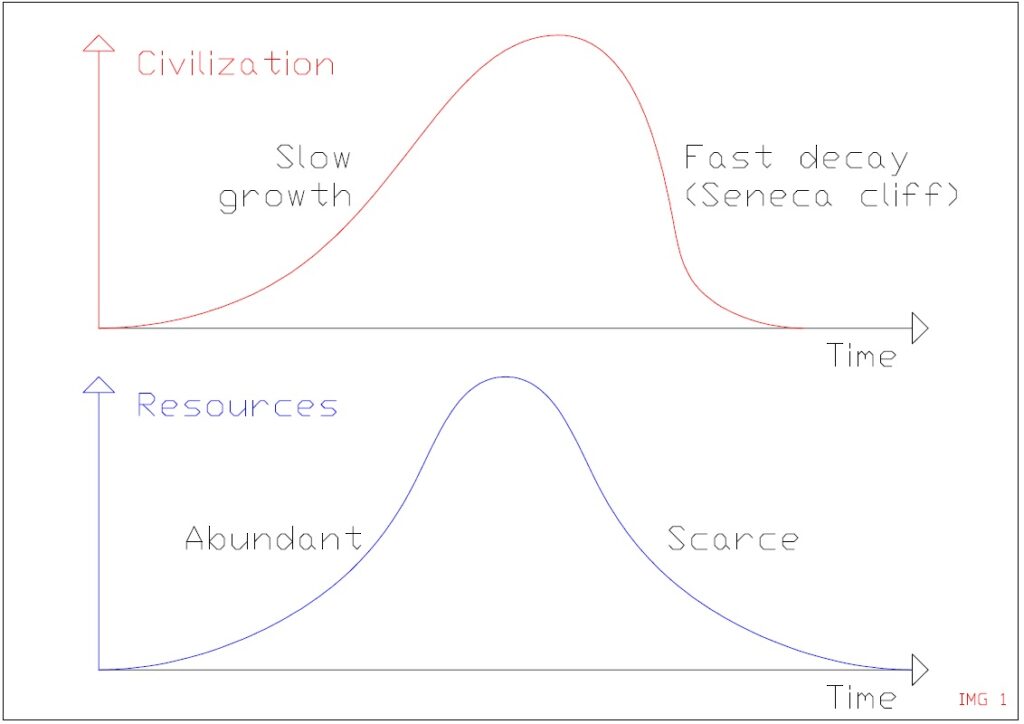Alien life and the Fermi paradox

Question: Is there life on Mars?
Answer: A little bit, mostly on Friday and Saturday nights!
This rhetoric question is at the core of the Fermi paradox, meaning if alien life exists then why haven’t they made contact nor can we see them around us?
Life as thermodynamic necessity
We discussed before how life, or the increase in biological complexity of molecules within certain planetary bodies, arises out of thermodynamical necessity, meaning life and subsequent intelligent type life eventually pops out a bit everywhere out there in the cosmos, making use of whatever base elements are available on said planets.
Still not every planet is created equal, and certain bodies have better conditions (Carnot and Chemical coefficients) to allow faster development than other less suited planets.
Once intelligent life develops, the copy paste technique suggests that the smartest one will spread on such planet first, then to nearby planets on that solar system, and ultimately to other galaxies, thus making it visible to other intelligent life forms on other solar systems sooner or later.
Travelling out of the box
Still the question remains: Where are all the aliens? Why are they not making contact with us?
Well, even assuming that intelligent alien life is out there, we need to ask ourselves, how easy it is to get out of your planetary box and get to other solar systems?
We have in fact an excellent post from Ugo Bardi on this very topic highlighting the hurdles of intergalactic travel: First thing first, you need to have an intelligent and industrialized civilization, this civilization needs to be “industrialized enough” to develop space travel, but this development is a race against time, a race against depletion of resources available on such planet, so there might be a finite amount of time available to such civilization to develop space exploration programs outside their solar system before their technological society collapses into the stone age once again.
This very problem is apparent on our planet too. As we industrialize and grow our technology, we deplete the energy and material resources whilst increasing pollution. A civilization grows slowly to higher technological heights but it eventually decays because of depletion and pollution taking over the race against entropy.
Often this decay is also enhanced by wars over said dwindling resources which cause destruction of critical life supporting infrastructures (not easy to rebuild in an energy starved world), thus precipitating the collapse of civil society even more.

Sure enough we have solar, wind, etc, but all these resources are too scarce and sparse to allow for a space age technological society, meaning that if we had to rely on these sources alone, our society would resemble more the one in the 18th century than the one in the 21st one, with no energy to spare for developing rockets and spaceships for space exploration programs.
First things first: The energy problem
So far humans have been pretty efficient at kicking the Seneca cliff of technological and societal unravel down the road of history by means of finding new resources and increasing complexity and specialization, but can we kick the can far enough to develop space travel and lift ourselves up there toward other solar systems?
The way we averted collapse in the past (and will be done in the future) was to jump ship toward newer and denser forms of energy capable to support our societal sophistication.
Academic consensus for the next best candidate appears to be nuclear fission. If we were capable of harnessing its full potential through 100% self breeding reactors or by means of external neutron source ignition reactors, then we would be able to use uranium and thorium stockpiles to their full potential and we would be able to live our current technological and energy lifestyle for the next 30.000 years!
However if we were to develop space travel to the outer solar system, our energy intensity would be quite different from today’s consumption and these nuclear stockpiles would only last few decades at best before the unavoidable collapse. If this was the case then there would be just a limited amount of time to send few ships out there before the mother planet of origin would unavoidably revert back to stone age or middle age at best.
So how do we lift off this rock we call Earth?
Once again we jump to the next best thing which would be nuclear fusion!
The status of the art on this technology is somewhat disappointing and the recent experiments and apparent breakthrough in December 2022 only shows how far fusion is off the mark both technologically and economically from useful energy production.
Just to put things into perspective on this experiment: 3.15 MJ heat where obtained out of a 2.05 MJ of laser energy, however, to make that laser energy available and considering the inefficiencies of laser technology and the thermal power plant technology currently available, then we had to spend about 550-450 MJ heat at the power station.
What does this mean? It means that nuclear fusion technology needs to improve overall system inefficiencies by a factor of about 16.000% (160 TIMES!), before we can even think of extracting any useful energy off this process as it is currently designed.
Of course there are other controlled nuclear fusion experiments which appear to be already at commercial stage but are not getting any adequate level of attention or funding. I leave the judgement of said claims and papers to history and finer minds capable of reading high physics, but it does seem like the debate around fusion is neatly divided between big projects and capitals chasing high hopes with no viable proof of concept, and on the other side of the ring we have seed and angel funding type projects with a new physic behind them yielding astounding results but with not enough attention for a more careful analysis and independent validation.
If we take a leap of faith and believe fusion is possible in a controlled way at some point in our technological future, then we could use the abundant minerals of Earth’s crust and mantel and slowly but surely fuse them all the way up to Iron (the final, exhaust stage of any nuclear fusion fuel), or even use raw minerals from other planets on our way to the Stars as fuel for our spaceships on the way through space.
Although there are no detailed calculations about the energy potential of this type of fusion, the technology holds the promise of expanding our energy horizon so far into the future that intergalactic space exploration might well be in the cards.
Of course a lot of advanced and intelligent civilizations might not quite reach the atomic fusion age, or not reach it without bumps and delays caused by inherently inefficient biological processes such as politicians, the issue with the old guard, and the inexorably approach of the Seneca cliff after which it might be very difficult to recover back up to an advanced technological state, should we fail to jump in time to the next best energy source.
The spacetime problem
Assuming that our society eventually makes it to the controlled nuclear fusion age and the energy problem is resolved for good, we still need to resolve the space problem, meaning that traveling from one solar system to the next will inexorably take a loooooong time since the speed of light is the ultimate speed limit in our reality.
If this is indeed the case then intelligent alien form might well be out there, but the time to spread around across the vastness of the universe is so hopelessly long that the chance of different alien species crossing each other paths is quite rare in the end.
There is still the possibility of faster than light travel technology by surfing through engineered perturbations of the Aetheric media. Again if this is possible then alien life forms would not just spread around to other galaxies and solar systems at fast pace, but they would mingle and socialize among each other relatively often.
Meet the aliens
If aliens are indeed among or nearby us, then we must assume that they themselves must have resolved the issues revolving around both the energy and spacetime, meaning they must be much more advanced than us both technologically and socially and we must look quite primitive to them, with all our unruly emotional and social problems of greed, prevarication and egoism in general.
Some might be tempted to think of aliens like the ones in the movie Independence Day, nothing more than marauders and looters of other planet resources. This is a typical human point of view because in a planet with a primitive technology and limited energy and resources available, this is how we are used to behave, which is to take whatever resource we need, even from others if needed be, in order to guarantee our lifestyle just a little bit longer.

On the other end, if you live in a society with unlimited energy, technology and wealth, then the struggle for survival and its efficient adaptative greed strategy is nothing more than a relic behavior of the past.
An advanced alien civilization capable of superlumniar travel and unlimited energy availability would look more like the alien in the movie Paul!

In fact the best strategy for said smart aliens is to let us be in this natural reserve called Earth, waiting for us to mature our way up into the intergalactic society at our own pace.
Getting too close to the humans would definitively upset most humans and our primitive military complex will likely cause much destruction and damage to ourselves in order to strike and avert a perceived hostile attack from an alien civilization trying to take over the Earth.
A final note about some of the alien minds that might be out there: Being extremely developed mentally and emphatically, their very presence can be fairly upsetting and unsettling to humans.
Only a small amount of highly balanced individuals can stand up and communicate with them without too many emotional side effects. Eventually time allows people to adapt and learn the mental ways of more advanced brains, a bit like the struggle of learning a new language.
